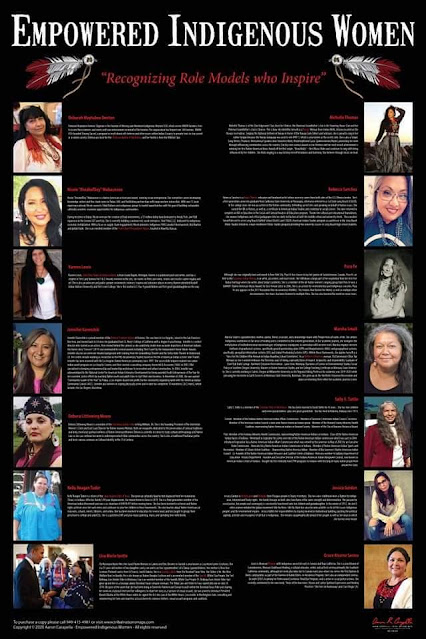Disclosure: Aaron Carapella gave me permission to use his copyrighted photos. They are all copyrighted by his company Tribal Nations Maps.
Although some people still celebrate the holiday as Columbus Day, many are changing it to Indigenous Peoples' Day. I shared years ago about how I feel about Columbus Day. For more reasons to change the day to Indigenous Peoples' Day check out here. To celebrate Indigenous Peoples' Day, I turned to my friend Aaron Carapella of Tribal Nations Maps. Years ago I had the pleasure of sharing my prize with you of one of his amazing maps. Since then he has added so many different maps and products. He has added maps Indigenous Peoples of regions of North America as well as Central and South America.
 |
| Aaron Carapella with his maps |
Today I am going to share his two products about Indigenous women. Now many of us have heard of Maria Tallchief and Wilma Mankiller as well as Pocahontas and Sacajawea, but Aaron features women you probably don't know and they are women who are making a difference today. The first product I am sharing today is the Inspirational Women of Native America.
As you can see there is a map of the United States. On the map are the traditional native tribe names and locations. Around this beautiful map are photos and bios of thirteen amazing Indigenous women. The women are
Candace Begody, Charlene Teters, Jacque Tahuka Nunez, Rose Ann Hamilton, Justina Lawatubee Fa’apouli, Kathy Willcuts, Diane Tells His Name (her Etsy store), Sandra Richardson-Hope, Yvette Neshi Lokotz, Erin GreyBull Harrison, Crystal Cavalier-Keck, Rene Locklear White, and Martina Hawkins. I have provided links to something about them that I found on-line. A few that are on the posters I will be sharing do not have anything public that I could find.
These women are artists, activists, teachers, military veterans, police officers and more. It is truly inspiring to learn about them. I thought I would take a closer look at a few of these women. We will start with the first one on there, Candace Begody.
Candace Begody is Navajo. She went to the University of Arizona and got her Bachelor of Arts in Journalism. She became the first female editor of the Navajo Times. She got her doctorate in law from the Sandra Day O'Connell College of Law at Arizona State University. She also earned her MBA from the W.P. Carey College of Business also at Arizona State University. I also see she hoped to run for a seat in the Arizona Senate but her nomination form lacked enough signatures. She was trying to run last minute. (Source)
Another one I found fascinating is Diane Tells His Name. Diane Tells His Name is Oglala Lakota. She is an advocate for children in foster and adoption care. She herself was adopted. She speaks, teaches and reunites other adult Native America with their Native families. She raised five children and returned to college at age 45. She is also a doll maker which truly fascinates me. Her dolls have no faces. She focuses on making dolls historically meaningful. Many come with a story. She has received many awards and her dolls are featured in many private collection as well as the Smithsonian Museum. She lives with her husband and they have thirteen grandchildren. (Source & Source)
The no face doll goes back to the corn husk dolls of the Northeastern tribes. There is a legend about the corn husk doll not having a face due to her vanity. The Creator sent a large screech owl to snatch the doll's reflection in the creek. The doll could no longer see her face and thus could not be vain about her beauty. Often when the Northeastern Native mother gives her daughter a doll, it usually does not have a face, and she tells her the legend of the Corn Husk Doll. They hope to teach their children humility with the dolls. Similarly the Lakota have no face dolls traditionally made from buck skin. Their bodies were stuffed with cattail fluff or buffalo hair. The hair was usually buffalo hair or horse hair. The clothes of the Lakota dolls reflected their own clothes with the beautiful beadwork as well as tools depending on the activity they represented. The tools were like baskets, cradleboards, knives or hunting tools. (Source)
The other poster I want to share with you is the Empowered Indigenous Women Poster. This beautiful poster shares photographs and bios of fourteen amazing Indigenous women. The women are: Deborah Maytubee Denton, Nicole “BreakofDay” Wabaunsee, Kareen Lewis, Jennifer Varenchik, Debora Littlewing Moore, Kelly Reagan Tudor (her book recommendations), Lisa Marie Iyotte, Michelle Thomas, Rebecca Sanchez (Teacher and Artist), Pura Fe, Marsha Small (on Indigenous Peoples' Day), Sally S. Tuttle, Jessica Gordon, and Grace Alvarez Sesma. These women are musicians, activists, teachers, writers, and more!
One of the fascinating things I found out was Michelle Thomas sang the National Anthem and the Marine Corps Hymn in Navajo. She was honoring the Code Talkers. Needless to say she is a singer, song-writer, producer, mother and more. (Source)
Each of the women featured on these two posters are making a difference in our world. They are using the talents they have and doing their best to help their fellow human being and the environment. I hope you will go to Tribal Nations Maps and check out these posters as well as the other amazing products.








